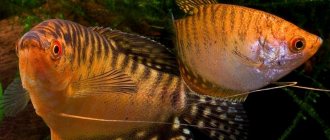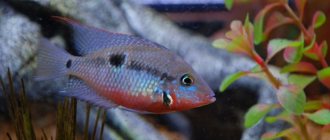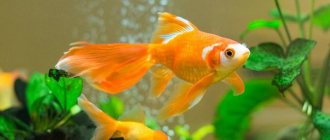Barbus
Barbs are ray-finned spawn-marking fish from the carp family, representatives of the genus Barbus.
They have become popular in the aquarium hobby because of their unpretentiousness and variety of colors (now there are even fluorescent ones). They are nimble and fast, but carry the stigma of being “badass”. Some even consider them predatory, but this is far from the case. Proper compatibility of barbs with other fish is quite possible. It's all about the right neighbors and a suitable aquarium.
Fluorescent barbs are a genetically modified species. They cannot reproduce.
Barbs live 5-7 years, but during this long life for a fish, many of them can only grow up to 5 cm. Although the size of some species can range from 6 to 35 cm.
Fish in their natural environment live in rivers and streams with slow currents and warm water (25 degrees), sandy soil and dense vegetation, which must be created in the aquarium. Barbs like to burrow into the ground so that they do not harm themselves; there should be sand there, not large pebbles or crushed stone.
Barbs in nature
In the wild, these interesting inhabitants of the underwater world are found in almost all bodies of water in Indonesia, China, Africa and India. Some species also live in the rivers of our country. The barb belongs to the genus of carp, most varieties of which are classified as commercial fish. Usually these are very large fish with unusually tasty meat. The varieties bred in aquariums are usually not particularly large in size. Their body length is most often no more than 5-7 cm.
Sumatran barbs
Most often, hobbyists keep unpretentious Sumatran barbs in aquariums. These are quite beautiful silver-colored fish with transverse black stripes on the body and a red lower fin. Albinos are also found among Sumatran barbs. The scales of the latter are cast in gold, and the stripes are white and almost invisible. The compatibility of barbs with other fish, if we are talking specifically about the Sumatran variety, raises doubts in many cases. You should select neighbors for these minke whales especially carefully. The fact is that this is the most aggressive variety.
Reviews
Barbs attract aquarists with their beauty and energy, as well as their unpretentiousness and omnivorous nature. But owners of slow-moving fish complain that barbs attack other fish. This is the main cause of dissatisfaction when keeping barbs.
Barbs "Mutant"
These fish can also often be seen in hobbyist aquariums. Their body shape is similar to the body shape of Sumatran barbs. The only difference is in color. This species can become a real decoration of your aquarium thanks to its bright dark green scales, red stigma and black fins with a red border. The character of green barbs is a little softer than that of Sumatran barbs, but you also need to choose the right neighbors for them.
Description
The black molly is one of the species artificially bred in 1930; it reaches sizes of 6-10 cm in an aquarium, and up to 12 cm in nature.
Life expectancy is about 3 years, but may be longer.
The black one has a completely black body, a deep velvety hue. Often there are forms with a lyre-shaped tail fin, the black lyre.
Latipina grows up to 10 cm in an aquarium, and up to 20 cm in nature. The body color is silvery-brown, with dark and blue dots. A distinctive feature is the high dorsal fin.
Velifera in general is very similar to Latipina, but now it has received a new and popular look - from it a completely white species has been bred - snowflake.
Characteristics of barbs
As already mentioned, these fish are extremely active. Therefore, it is best for them to purchase an aquarium that is very elongated in length. The composition of the water does not play a special role for these fish. One of their main characteristics is unpretentiousness. Therefore, the compatibility of barbs with other fish, which are equally undemanding, quite active and not too aggressive, is not a question that raises any doubts. We’ll look at who exactly can join them in detail below.
Another feature of barbs is that they love to ruffle the long fins and tails of their neighbors in the aquarium. This should also be taken into account when selecting residents of your home underwater corner.
Barbs and angelfish
It is believed that these two species of fish do not get along very well in the same aquarium. However, in reality, in most cases it all depends on the conditions in that particular aquarium. If it has a significant volume (at least 100 l), coexistence of these two species of fish is possible. But then, when there are not too many barbs in the aquarium, and the angelfish are quite large. However, even under such conditions, the latter must be planted carefully. At first, you need to observe the behavior of the fish. Most likely, the angelfish will have to be removed from the aquarium soon. There will be less danger for them if they are planted in the aquarium first, and a little later add several barbs. In this case, the angelfish will feel in their territory. Active minke whales will still have to get used to it. Also, peaceful relations depend on the age at which barbs and angelfish were acquired. The compatibility of fish if they grew up together is beyond doubt among many aquarists.
What you should pay attention to
Aquarium volume
Single bettas can live without problems in aquariums of about 10 liters. However, if you decide not to limit yourself to just one fish, then take care in advance of a container of a suitable size, and the larger the volume, the more comfortable the coexistence of the fish will be.
Shelters
When keeping such temperamental fish as bettas, you always need to be prepared for possible conflicts. To minimize the consequences of skirmishes, equip the aquarium with sufficient hiding places. First of all, plant more living plants, put up driftwood and artificial grottoes. Shelters will allow the fish to hide from the aggressor in time.
Behavior Observation
Keeping bettas in a community aquarium requires constant vigilance. Be sure to control the attitude of the cockerel towards its neighbors. If he chases other fish or makes attempts to gnaw off the fins of his neighbors, then the best option would be to put the “evil one” in a separate aquarium.
Possibility of single content
If you still had to remove the betta from the community aquarium, then don’t worry. These fish are solitary by nature, and the lack of company will not bother them at all.
DISEASES OF MACROPODS: CAUSES AND TREATMENT
HOW TO DISTINGUISH A FEMALE FROM A MALE MACROPOD?
ZANIO HOW TO DISTINGUISH A FEMALE FROM A MALE
HOW TO DISTINGUISH A FEMALE FROM A MALE MOLLINESIA?
Barbs and neons
The compatibility of these two varieties with each other is also a rather controversial issue. Experts believe that such a neighborhood cannot end in anything particularly good. However, many aquarists actually have quite success keeping fish such as barbs and neons together. The compatibility of these two varieties actually depends on many factors. For example, if there are many plants planted in the aquarium, the neon will have somewhere to hide, and the barbs are unlikely to cause them significant harm. In principle, the rules for sharing in this case are the same as for angelfish. That is, it is better to add neons to barbs, and not vice versa, and buy fish at a very young age.
Which fish are neon's best friends?
Neons are small freshwater fish of the Characin family. In the wild, they are very active and nimble, able to quickly hide from predators, maneuvering among dense plants. Body dimensions reach 3 cm in length, life expectancy depends on water temperature: from 1.5 to 3 years. Behavioral characteristics: due to their peaceful disposition, they can get along both with each other in a school and with other species of fish. Guppy fish and neons, platies and neons, catfish and neons get along well in the same aquarium. This compatibility is beneficial for beginning aquarists, since these types of fish will definitely not harm each other.
What else needs to be considered for compatibility? Neon males are brighter in color than females; the contrast of scales depends on the species. But they have one thing in common - a horizontal strip runs through the body, which sparkles with a “neon” flicker even in the dark. This feature can be attractive to predatory fish and those who do not welcome more beautiful neighbors near them. So place a school of neons of 5-7 fish or more in a spacious tank with shelters, so that in case of unforeseen attacks, they can hide in time.
Rules for settling in a community aquarium
Neons are characterized by calm behavior, and only during the spawning period they become overly active and cocky. Therefore, choose fish as neighbors for them that are not predatory, but omnivorous or herbivorous, balanced and not very playful. There are a number of rules that are important to ensure that the compatibility of neons with other fish in the aquarium is as successful as possible.
Look at a good option for a community aquarium with neons.
- Compatibility is possible between fish that live in similar environments in the wild. Neon fish live in water with a temperature of 18-24oC, acidity 5.5-7.5 pH, hardness 8-20o. Therefore, their neighbors in the aquarium must be adapted to similar parameters.
- Neons should not be housed with large predators that feed exclusively on meat and carrion. Otherwise, peace-loving neons will become prey for them - their fins may be torn off, at a minimum.
- You cannot place large and small fish in a common aquarium; such incompatibility can cause severe stress or loss of bright body color.
- Choose neighbors who are similar in temperament. Small and nimble fish will feel comfortable in the company of calm and slow-moving fish. What is it for? The fact is that the activity of fish can provoke water fluctuations, which can lead to stress.
- Neons are schooling fish, not loners. They feel good in the company of similar relatives; the fish will not live long alone.
- A territorial niche must be established in the aquarium. That is, all types of fish must swim in certain layers of water - lower, middle or upper. This way they won't interfere with each other. Neons, like corydoras catfish, swim in the bottom layer of the aquatic environment.
- Neons love plants not as a treat, but as decorations or shelters among which they can swim or hide. If other aquarium fish chew the leaves, or are prone to such sabotage, the neons may suffer greatly.
- When sick, all fish need to be treated, and treatment methods may not be the same for all fish. Some tolerate treatment with salt and copper, while others do not. Neons are not particularly sensitive to copper-based medications. Therefore, fish with the same tolerance can become their neighbors. Then treatment can take place in a common aquarium.
Who Neons Can and Can't Get Along With
Neons get along well in a home pond with the following aquarium fish: Poeciliids (guppies, swordtails, mollies, platies), speckled and panda catfishes, tetras, zebrafish, labeo, rasboras, minors, gouramis, iris, pulchers, minors, and shrimp. Let's look at compatibility with some fish in more detail.
Look how well angelfish and neons get along in the same aquarium.
Corydoras catfish are excellent neighbors for small characins; they live together in the bottom layers of the aquarium and collect the remains of uneaten food. Corydoras are harmless fish, also small and peaceful, love to watch their neighbors without harming them.
Rasboras can be an excellent company for neons. Among them: rasboras proper, boraras, microrasboras and trigonustigmas, some of them belong to the Cyprinidae family.
Fishes of the Poeciliaceae family (guppies, molly, swordtails, platies) coexist peacefully with characins. Swordtails are also distinguished by their small body size, but males can be overly active. It should be taken into account that more than two male swordtails sometimes chase smaller neighbors, especially during the spawning period. With insufficient feeding, in cramped conditions, with a small place for swimming, swordtails become unbearable. To prevent these fish from terrorizing small neons, the aquarium must be spacious, with sufficient plants and hiding places.
Neons are not compatible with the following fish:
- Large catfish, cichlids, barbs, astronotus, bettas, koi carps - those that live in cool water or have predatory, aggressive behavior.
- Goldfish - they live in cool water and are aggressive towards brightly colored fish and their offspring.
- Angelfish - can live with neons only if they all grew up together from the age of the young. But angelfish will perceive neon strangers as food. Also, during the mating season, angelfish will be aggressive towards everyone, including these small fish.
AkvariumnyeRybki.ru>
Barbs and guppies: compatibility
Guppies are perhaps the most beloved and popular fish among aquarists. Therefore, the question of whether it is possible to keep barbs together with them is quite natural. In fact, such a neighborhood usually does not end well. Guppies placed near barbs will most likely be driven to death. In the same case, if the fish grew up together, of course, nothing will happen to them. However, the owners of the aquarium will hardly be able to admire the beautiful fins of the guppy.
As mentioned above, barbs and neons, whose compatibility is also questionable, get along well together if there are many plants in the aquarium. The same applies to guppies. Plant more Vallisneria, Kambob, aquatic ferns, etc. in the aquarium, and they will have a place to hide from annoying striped or green neighbors.
Barbus fish: compatibility with cichlids
In this case, the aquarist should not expect good neighborly relations either. And this time it’s not about the barbs at all. Cichlids are perhaps the most aggressive fish of all, intended for home breeding in aquariums. They don't get along with practically anyone. The only fish they don’t touch are various kinds of bottom-dwelling catfish. You can only try to keep adult barbs and young cichlids together. After the latter grow up, it is best to remove them from the aquarium. Even being well acquainted with the local barbs, adult cichlids will not miss the opportunity to become the absolute masters of the territory.
Breeding
Barbus is easy to breed in captivity. To do this, you need to use a small aquarium, 10, 20 liters. It acts as a spawning tank. Then you need to add old water taken from a common tank to it. At the next stage, you need to add about 1/3 of fresh, clean, well-settled water. The bottom of the spawning tank must first be lined with Java moss and cabomba. They will act as a substrate during the spawning period. You can use a separator mesh, which is placed at a distance of 2 centimeters from the bottom of the aquarium.
Important! You can breed barbels without a spawning tank, in a community aquarium. To do this, it is necessary to fulfill certain conditions, namely: increase the water temperature to 28 degrees Celsius, plant a common reservoir with dense underwater vegetation.
Before spawning begins, the male and female are kept in separate tanks for two weeks. They must be fed animal food. Bloodworms and cyclops are perfect. A signal that a female is ready to reproduce is her protruding, full belly.
The spawning tank must be located in a well-lit place. It is preferable to launch fish for spawning in the dark. During 1 spawning, a female can produce 400 eggs. After spawning, the fish should be immediately moved to a common tank. Otherwise, they may destroy the eggs.
For the larvae to hatch, the temperature of the spawning water should be in the range of 25-26 degrees Celsius. Initially hatched fry do not show increased activity. After 4 days, they will already begin to actively swim in the spawning area and look for food. At first, it is better to feed the fry rotifers and ciliates. Then, as they grow, it is preferable to use small crustaceans as food. It is important to timely sort the fry according to their size to avoid cases of cannibalism.
What fish can you keep with?
Such fish as Sumatran barbs have very good compatibility with redfish. The behavior of the latter is similar to neon. However, they are not so whimsical and timid, and are practically not subject to stress. That's why they don't die from the slightest trifle. Among other things, the decorative qualities of the aquarium will also benefit from such a neighborhood. The transverse stripes of the Sumatran beauties go very well with the longitudinal zebrafish.
The compatibility of barbs with other fish is beyond doubt even when we are talking about representatives of characins. These could be, for example, ornathuses, minors, ternets or pristellas. Like cichlids, barbs do not touch various types of catfish. They also get along well with active swordtails. Being a little aggressive by nature, the latter, most likely, will not allow themselves to be offended. The same goes for gouramis and parrots.
The varieties mentioned above may well become very good neighbors for barbs. However, most often - for variety - simply different varieties are planted in aquariums at the same time. Sumatran, fiery, cherry, green barbs, etc. get along very well together.
Content Features
Aquarium fish barbs, the compatibility of which with other species, as we have found out, largely depends on the conditions of keeping and growing, despite their unpretentiousness, they still require compliance with certain rules of care. Experts recommend:
- Keep them only in flocks.
- Be sure to plant more plants in the aquarium. They should become one of the sources of oxygen needed by barbs.
- The minimum aquarium volume for small-sized varieties (Sumatran, “mutants”, etc.) is 50 liters.
- It is definitely worth aeration and filtration.
- Barbs eat a lot. They should be fed frequently and in small portions. Food should be as varied as possible. This fish eats bloodworms, tubifex, cyclops, and daphnia very well. Dry food is also allowed from time to time. Cucumber gruel or finely chopped lettuce can also be a good food for barbs. Whether the fish have enough food can be judged by the condition of the aquarium plants. If they are plucked, it means that the quantity is not enough.
Adviсe
- Do not overfeed barbs.
- Plant a sufficient number of plants.
- Choose a shallow aquarium rather than a long one.
- Do not share with slow and stately fish.
- Do not share with small fish or fry.
The Sumatran barb will enliven any aquarium with its cheerful temperament and will be an excellent decoration. If it seems to you that the aquarium has become slow and lifeless, then buy a barb. These fish will quickly create vigorous activity in the water; all you have to do is watch them.
Previous
Varieties of Molliesia reproduction: fry, pregnancy, childbirth, breeding (spawning) of aquarium fish, what to feed at home
Next
Varieties of barb fish: maintenance and care, compatibility, reproduction, feeding, life expectancy in a home aquarium
Great article 0
Reproduction
The barb, whose compatibility with other fish was discussed above, belongs to the spawn-marking class. At one time, the female can bring up to 500 eggs. Producers will need to be seeded before spawning. Particular attention should be paid to proper feeding at this time. Fish need to be given a lot of live food. After spawning, females are removed from the aquarium. The fry begin to be fed on the third day after hatching. Very young children are fed rotifers or artemia. In the future, larger types of food can be given. The fry should be fed very often, which is due to their very rapid growth.
Thus, the compatibility of barbs with other fish, active and non-aggressive, is beyond doubt. It is better not to house them together with representatives of the underwater world that are slow, timid, or have beautiful long or wide fins. If you want to see these beautiful, interesting, live fish in your aquarium, you should definitely take this into account. And, of course, you need to care for barbs correctly. In this case, there will be much fewer problems with their maintenance.
Who do betta fish get along with in a community aquarium?
Today, bettas (lat. Betta splendens) are popular aquarium fish. They belong to the Macropod family, suborder Labyrinth fish.
Cockerels have a cocky character, for which they are nicknamed “fighting fish.” They do not always tolerate settlements with other fish; it is difficult for them to live with neighbors due to their pugnacity. If you place a male betta in the same aquarium with another betta, then conflicts will arise between them, which will end in bodily harm and plucked fins. But this does not mean at all that they cannot be housed with fish. On the contrary, a good neighborhood harmonizes life in the aquarium. If your tank is spacious, has a beautiful aquascape created in it, reminiscent of a natural biotope, there are a lot of plants, shelters, and a biological balance has been established - then all the inhabitants will be comfortable. An important rule is that you cannot have more than one male betta living within the same aquarium. They cannot be called territorial fish, but it so happens that they will fight. You can house several females for one male, so he will be comfortable.
Female Betta splendens are smaller in size, their fins are shorter, and their character is calmer. But females can also conflict both with each other and with the male. Females can be kept in one nursery of 3-4 individuals. They are less aggressive, but their character is also unpredictable. If you notice that betta fish are constantly aggressive towards their neighbors, and this leads to fatal consequences, then do not spare money for another tank, placing a restless pet in it.
Rules for keeping Betta splendens in a common tank
These fish tolerate temperature changes well and can thrive at temperatures of +18 and +25 degrees Celsius. But sudden changes should not be allowed, as they are harmful to the pet’s health. Like a labyrinth fish, the betta should live in water that corresponds to the ambient air temperature in the room: +22-26 degrees. Due to the fact that he can breathe with a labyrinth organ, aeration is not necessary - this should be taken into account when introducing other fish that cannot live without dissolved oxygen. The water must be replaced once a week, 20% of the total volume of the tank. Don't forget to clean the bottom of food debris and dirt.
What rules must be followed so that bettas can live peacefully in an aquarium with other fish? These rules apply to all cockerels, thanks to which peaceful cohabitation with representatives of different species of fish can be achieved.
- It is not recommended to keep fish with long fins and brightly colored scales with bettas. Although the cockerels themselves are distinguished by their beautiful appearance, they are sensitive to “competitors” who are like external irritants for them.
- You cannot house cockerels with large and predatory fish, for example, African and South American cichlids. The latter themselves are peaceful and friendly creatures, but they do not get along with fighting fish.
- Try to keep your fish in water that is suitable for everyone. It is impossible to settle heat-loving species and cold-loving ones. For example, goldfish cannot live in warm water, so they are incompatible with betta fish.
- Betta splendens fish can be housed with speckled catfish, tetras, gouramis, swordtails, and mollies. After settling the fish in the aquarium, observe their behavior. You can also keep the fish together from a young age, so they will get used to each other better. Fish should not be less than 5 cm in length. If your neighbor's fish has died, do not add a new fish to the cockerel, otherwise he will kill it.
- Compatibility with other fish will be successful if the betta lives in a spacious tank of 50-100 liters. You can put a lot of decor and shelters there, which will nullify territorial claims and conflicts.
Take a look at a community aquarium with bettas.
There are aquarium fish with which bettas are well compatible; they live peacefully, with periodic fights that do not lead to death. These fish include marbled gourami, cardinals, labeo, lalius, macrognathus, and angelfish. But it should be taken into account that during the first days of settlement it is necessary to monitor their reaction; in case of aggression, they are settled separately from each other.
The fish Betta splendens has almost perfect compatibility with platies, iridescents, black mollies, ornathuses, grumbling gouramis, acanthophthalmus, befortia, ancistrus, minors, otocincles, rasboras, thorns, congos, botias, tarakatums, loricarias, Siamese gastromyzons, brocade catfishes.
Description of compatibility with certain fish species
Cockerels and guppies - it is believed that guppies and bettas live in water with different parameters, therefore they are only conditionally compatible. There have been examples of successful compatibility, but it’s not always worth the risk. Bettas can chase guppies throughout the aquarium until their fins are torn off. Guppies can live at temperatures of 18-28 degrees, although 22-25 degrees is a more tolerable temperature for them. The diet of both fish is the same, so some breeders did not have any difficulties in keeping them.
Angelfish and bettas - compatibility is not bad, provided there is a spacious tank. These fish practically ignore each other, without attracting attention to themselves. The cockerels would rather fight among themselves than bother the angelfish. However, during spawning, angelfish become more aggressive and can drive all their neighbors, including labyrinths. Provide plenty of cover and plants in the nursery to keep everyone safe.
Gourami - all species are close relatives of cockerels, so compatibility can be excellent. Gourami are curious creatures, tenacious and active, they also feed and breathe through gills and atmospheric oxygen. The cockerels do not bother them, sometimes the opposite happens. Place them together in a tank of at least 70 cubic liters. All Macropodidae have the same enemies: these are large and predatory fish, with which they should not be housed.
Look at the cockerels in company with the gouramis.
Mollies and bettas can live in an aquarium because they tolerate the same water parameters. But one fact is that mollies prefer slightly brackish water, but bettas do not. Temperatures of 24-27 degrees are optimal for keeping. At low temperatures, both fish begin to get sick. Mollies are viviparous fish that must breed in a separate spawning tank so that no one destroys their fry.
Botia are aggressive hydrobionts alone, so they can only be added to males in a flock of 4-7 fish. In the aquarium, bots are small, reaching only 8 cm in length. Peaceful, they can be kept with similar neighbors, provided there is space and shelter. Cockerels practically do not conflict with them.
Corydoras are suitable as neighbors for many fish. They have a calm disposition, interesting body color, and bring a lot of benefits. If the cockerel does not finish the food, the corridor will pick it up. Catfish swim at the bottom of the aquarium, bettas only sleep at the bottom. Compatibility between them has been proven; cockerels rarely bother Corydoras. Corydoras, like labyrinths, can use atmospheric air for breathing. Such a pet can survive under critical conditions. Catfish do not tolerate salt and organic matter well, just like bettas. The water in a community aquarium should be changed once a week.
AkvariumnyeRybki.ru>











